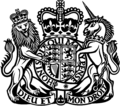Coat of arms of the United Kingdom facts for kids
Quick facts for kids Royal coat of armsof the United Kingdom |
|
|---|---|
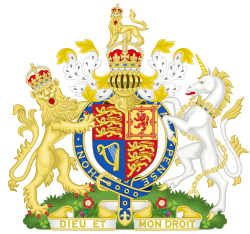 |
|
| Versions | |
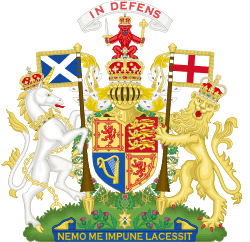
|
|
| Armiger | King Charles III in right of the Crown |
| Adopted | 1837 |
| Crest | Upon the helm, the imperial crown proper thereon a lion statant guardant Or langued Gules armed Argent, imperially crowned Proper; mantled Or doubled Ermine |
| Blazon | Quarterly, I and IV Gules, three lions passant guardant in pale Or langued and armed Azure. II Or a lion rampant Gules armed and langued Azure within a double tressure flory-counter-flory Gules. III Azure a harp Or stringed Argent.; quarters for England and Scotland are exchanged in Scotland. |
| Supporters | On the dexter a lion rampant guardant Or langued and armed Gules, imperially crowned Proper. On the sinister a Unicorn rampant Argent armed crined and unguled Or, and gorged with a Coronet composed of crosses patee and fleurs-de-lis, a chain affixed thereto passing through the forelegs and reflexed over the back Or |
| Compartment | Tudor rose, Shamrock, and Thistle |
| Motto | French: Dieu et mon droit, lit. 'God and my right' |
| Order(s) | Order of the Garter Order of the Thistle (Scottish version) |
| Earlier version(s) | see below |
| Use | On all Acts of Parliament; the cover of all UK passports; various government departments; adapted for the reverse of coins of the pound sterling (2008) |
The royal coat of arms of the United Kingdom is the official symbol of the British monarch, currently King Charles III. It's like a special badge that shows who is in charge. Different versions of this royal symbol are used by other members of the British royal family. It is also used by the Government of the United Kingdom. You can even see it in some courts and parliaments in countries that are part of the Commonwealth realms.
There are two main versions of the royal arms. One is used in Scotland, which has special Scottish symbols. The other is used everywhere else. Both versions have a shield with four sections. These sections show the lions of England, the lion of Scotland, and the harp of Ireland. The royal arms grew from the symbols of the old kingdoms of England, Scotland, and Ireland. Even though Wales was part of the Kingdom of England, it has never had its own symbol on the main shield. This coat of arms is also the basis for the King's official flag, called the Royal Standard.
Contents
What Does the Royal Coat of Arms Look Like?
The Version Used Outside Scotland
The main part of the royal arms is a shield divided into four sections.
- The first and fourth sections show three golden lions walking and looking at you. These are the symbols of England.
- The second section has a red lion standing on its hind legs. This is the symbol of Scotland. It is surrounded by a special border called a "double tressure flory-counterflory."
- The third section shows a golden harp, which represents Ireland.
Around the shield is a blue belt with a motto. This belt is part of the Order of the Garter. This is the United Kingdom's most important group of knights. On either side of the shield are two animals called "supporters."
- On the right side (called the "dexter" in heraldry) is a golden lion wearing a crown. This is the English lion.
- On the left side (called the "sinister") is a white unicorn with a chain around its neck. This is the Scottish unicorn.
Above the shield is a gold helmet. It has a fabric decoration (called "mantling") that is gold and white. On top of the helmet is the "crest." This is a crown with a crowned golden lion standing on it. Below the shield is a green grassy area. On this area, you can see thistles for Scotland, Tudor roses for England, and shamrocks for Ireland. In front of this is the motto, which is a French phrase: Dieu et mon droit. This means 'God and my right'.
King Charles III now uses a "Tudor Crown" design in the royal arms. This design was used before by kings and queens until 1952.
The Version Used in Scotland
The royal arms in Scotland use the same basic parts. But they have special Scottish symbols.
- On the shield, the Scottish symbols are in the first and fourth sections. The English symbols are in the second section. This shows that Scotland comes first in its own country.
- The shield is surrounded by the Order of the Thistle. This is Scotland's main order of knighthood.
- The crest is a crowned red lion. It holds a sword and a sceptre, which are symbols of Scotland's royal power. This lion faces forward and sits on a crown.
- Above the crest is the Scottish motto: 'In defens'. This is a shorter way of saying 'In my defens God me defend'.
- The supporters are different too. On the right side is a crowned and chained Scottish unicorn. On the left side is a crowned English lion. Each supporter holds a flag of its kingdom.
- The grassy area below the shield only has thistles. On it is another motto from the Order of the Thistle: Nemo me impune lacessit. This means 'No one will attack me without being punished'.
- The crowns in the Scottish version look like the Crown of Scotland.
How the Royal Arms Changed Over Time
Early English and Scottish Arms
The royal arms we see today started from the symbols of the old kingdoms of England and Scotland. These symbols were first used in the 1100s. For a long time, the English arms included symbols of France. This was because English kings claimed to be kings of France too. The Scottish arms mostly stayed the same.
In 1603, James VI of Scotland also became King of England and Ireland. To show this union of the crowns, the arms of England (with France) and Ireland were combined with Scotland's. Later, during the time of the Commonwealth (when there was no king or queen), the arms changed a lot. The Irish harp was still used. But England was shown by St George's Cross and Scotland by St Andrew's Cross.
Great Britain and the United Kingdom
When England and Scotland joined to form the Kingdom of Great Britain in 1707, their arms were combined. In 1714, George I became king. He was also the ruler of Hanover (a German state). So, the arms of Hanover were added.
In 1801, Great Britain and Ireland joined to form the United Kingdom. At this time, the British king stopped claiming to be king of France. So, the French symbols were removed from the royal arms. The English symbols were put in the first and fourth sections. Scotland was in the second, and Ireland in the third. The Hanoverian arms were still there, but they were removed in 1837. This happened when Queen Victoria became queen of the UK. She could not rule Hanover because of their laws.
Since 1837, the royal arms have mostly stayed the same. Only small changes have been made to how they look. For example, the Irish harp was changed so it no longer showed a bare-breasted woman.
Wales and the Royal Arms
Wales is not shown directly on the royal arms. This is because Wales became a part of England a long time ago. The Tudor monarchs, who had Welsh family, used a Welsh dragon as a supporter. But this was replaced by the Scottish unicorn when the next royal family, the Stuarts, took the throne.
Today, the arms of Wales are sometimes added to the coat of arms of the Prince of Wales. This is a special symbol for the Prince. There is also a Royal Badge of Wales that is used on official documents in Wales.
How the Royal Arms Are Used Today
Government and Courts
The UK Government uses a simpler version of the royal arms. This version does not have the helmet or the fabric decoration. It also has a simpler crest. You can see this symbol on all Acts of Parliament (laws). It is also on the logos of government departments. You will find it on the cover of all UK passports.
In England and Wales, the royal arms are often seen in courtrooms. They are usually behind the judge. This shows that justice comes from the King or Queen. Some courts in other Commonwealth countries also use the royal arms.
Other Official Uses
Royal Standard
A flag with the royal arms, called the Royal Standard, is flown when the King or Queen is at a building. For example, the Palace of Westminster usually flies the Union Flag. But when the monarch is there for the opening of Parliament, the Royal Standard is flown instead.
Coins
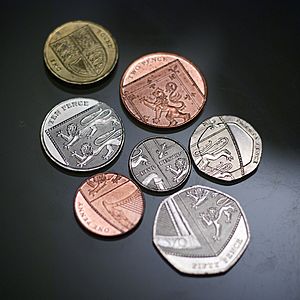
The royal arms are often on British coins. The Royal Mint, which makes coins, uses it as its logo. In 2008, new designs for coins were made. The full royal arms appear on the one pound coin. Parts of the arms appear on other coins. If you put them together, they form the complete royal arms.
Armed Forces
The royal arms (without the helmet) are used as a special badge for high-ranking officers in the UK's armed forces.
Churches
Many churches in the Church of England and Church of Scotland display the royal arms. This shows their loyalty to the King or Queen.
Businesses
The King or Queen can give special permission to businesses. This allows them to display the royal arms on their products or stationery. This shows that they supply goods or services to the royal family. Some newspapers also use the royal arms as their logo.
Royal Family's Personal Arms
Members of the British royal family have their own special versions of the royal arms. These are given to them by a special document called a "royal warrant."
- Children of the monarch have a white "label" with three points added to their arms.
- Grandchildren of the monarch have a white "label" with five points.
- Each prince or princess has unique marks on their label to make their arms different. The Prince of Wales uses a plain white three-pointed label. Since 1911, the Prince of Wales's arms also include a small shield with the ancient arms of Wales.
Wives of the King's sons also have their own coat of arms. This usually combines their husband's arms with their own family arms. However, husbands of a Queen who rules (like Prince Philip, Queen Elizabeth II's husband) do not use the royal arms. They get their own personal arms.
Here are some members of the royal family and their personal arms:
| Picture | Shield | Who Uses It | What Makes It Different |
|---|---|---|---|
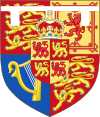 |
William, Prince of Wales, outside Scotland | This is the coat of arms for the Prince of Wales. It has a white label with three points. It also has a small shield with the arms of Wales. | |
 |
 |
Prince William, Duke of Rothesay, in Scotland | In Scotland, Prince William uses arms that are different. They include symbols for the Prince of Scotland and Lord of the Isles. They also have a blue three-point label. |
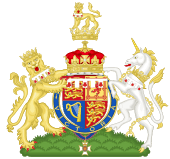 |
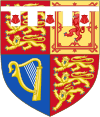 |
Prince Harry, Duke of Sussex | Prince Harry's arms have a three-point label. Each point has three red shell shapes. These shapes are a nod to his mother, Diana, Princess of Wales. |
 |
 |
Anne, Princess Royal | The Princess Royal's arms have a three-point label. The points have a red cross, a red heart, and another red cross. |
 |
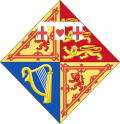 |
This is the Scottish version of the Princess Royal's arms. It also has a three-point label with a red cross, a red heart, and a red cross. | |
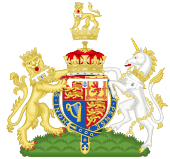 |
 |
Prince Andrew, Duke of York | Prince Andrew's arms have a three-point label. The middle point has a blue anchor. |
 |
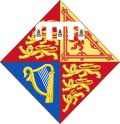 |
Princess Beatrice, Mrs Edoardo Mapelli Mozzi | Princess Beatrice's arms have a five-point label. It has three bees in every other point. These bees are a nod to her mother, Sarah, Duchess of York. |
 |
 |
Princess Eugenie, Mrs Jack Brooksbank | Princess Eugenie's arms have a five-point label. It has three thistles in every other point. These thistles are a nod to her mother, Sarah, Duchess of York. |
 |
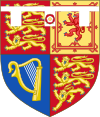 |
Prince Edward, Duke of Edinburgh | Prince Edward's arms have a three-point label. The middle point has a Tudor rose. |
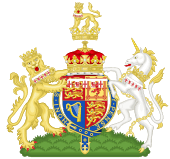 |
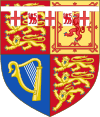 |
Prince Richard, Duke of Gloucester | Prince Richard's arms have a five-point label. The first, third, and fifth points have a red cross. The second and fourth points have a red lion. |
 |
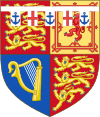 |
Prince Edward, Duke of Kent | Prince Edward's arms have a five-point label. The first, third, and fifth points have a blue anchor. The second and fourth points have a red cross. |
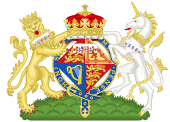 |
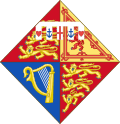 |
Princess Alexandra, The Hon. Lady Ogilvy | Princess Alexandra's arms have a five-point label. The first and fifth points have a red heart. The second and fourth points have a blue anchor. The third point has a red cross. |
 |
 |
Prince Michael of Kent | Prince Michael's arms have a five-point label. The first, third, and fifth points have a red cross. The second and fourth points have a blue anchor. |
| Queens and Wives of Princes | |||
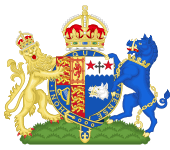 |
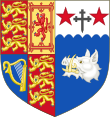 |
Queen Camilla | Queen Camilla's arms combine the King's arms with her father's arms. They are topped with the royal crown. |
 |
 |
This is the Scottish version of the Queen's coat of arms, also with the royal crown. | |
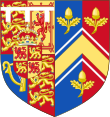 |
Catherine, Princess of Wales | The Princess of Wales's arms combine her husband's arms with her father's arms. | |
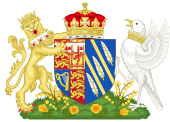 |
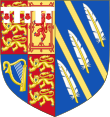 |
Meghan, Duchess of Sussex | The Duchess of Sussex's arms combine her husband's arms with her own design. They are topped with a special small crown for a child of the King. |
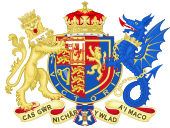 |
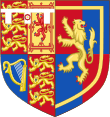 |
Sophie, Duchess of Edinburgh | The Duchess of Edinburgh's arms combine her husband's arms with her father's arms. The lion in her arms is a nod to one of her old family members. |
 |
 |
Birgitte, Duchess of Gloucester | The Duchess of Gloucester's arms combine her husband's arms with a small shield of her own. |
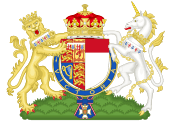 |
 |
Katharine, Duchess of Kent | The Duchess of Kent's arms combine her husband's arms with her father's arms. |
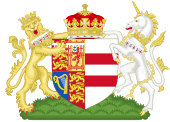 |
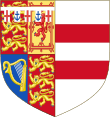 |
Princess Michael of Kent | Princess Michael of Kent's arms combine her husband's arms with her father's arms. |
Images for kids
-
St Michael's Parish Church, Linlithgow, Scotland: Scottish version of the royal arms of the Hanoverians, used from 1801 to 1816
See also
 In Spanish: Escudo del Reino Unido para niños
In Spanish: Escudo del Reino Unido para niños





